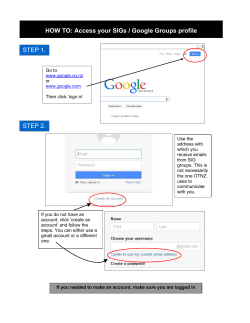
LESSON 15.2: PROFESSIONAL COMMUNICATION Module 15: Health Careers
Obj. 15.2: Use professional communication etiquette and norms. LESSON 15.2: PROFESSIONAL COMMUNICATION Module 15: Health Careers Do Now: Your Communication Style Answer the following questions to reflect upon your communication style. List all the ways you communicate with others (e.g., text, phone call, face to face, etc.). What is your preferred way to communicate with friends? What is your preferred way to communicate with family? What is your preferred way to communicate with other adults (e.g. teacher, coach, employer)? Were any of those questions difficult to answer? If so, why? What factors do you consider when deciding which form of communication to use? Professional Communication With a partner, discuss: In what ways do you currently communication with professionals and in what ways will you communicate in the future? What aspects of professional communication are you most comfortable with? Least comfortable with? Professional Email Critique Read over the email on the following slide. This email was sent by a real high school student to a real college professor who had agreed to mentor the student. After you read the email, write in any edits to grammar and spelling directly on the email. Then jot down ways the email could be improved in the box below. Professional Email Critique From: Student <student@gmail.com> To: Mentor <mentor@gmail.com> Date: 9/1/15 Subject: Hi Dear Mentor, Hello, My name is XXXXXXXX. I know you have a busy schedule, but this email is just to let you know I'm excited with working with you. I am excited to be working with you. I know there might be some difficulties but I am here to let you know I will work my hardest. Thank you for taking time to read this. I am very excited.! Have a nice day. Regards, XXXXXXXX Professional Email Critique Email Etiquette While there are many forms of communication, email is easily the most common in many of today’s workplaces. Writing multiple professional emails is an essential everyday task in many jobs. Yet an email can make a lasting first impression or change the impression others already have of you, in ways that can be either good or bad. Read on for some email etiquette tips. Then you will partner up to come up with your own additional tips to add to the list! Email Etiquette 1. Be concise. If the email warrants a long response, consider calling the person or talking face to face instead. Avoid wordiness and use bullets or numbered lists when appropriate. 2. Be clear. Get directly to your point as soon as possible. Don’t leave the reader confused or guessing about anything. 3. Use appropriate language. Consider your audience. Use language that conveys a professional tone. 4. Be cordial and polite. Use manners the way you would in real conversation. Say please and thank you. Be cheerful. 5. Respond to emails in a timely fashion. Replying the same or the next day is a standard in many workplaces. Waiting up to two business days is sometimes okay. But if you know you need longer than that, send a quick update and acknowledgement email to the email sender explaining when you will be able to send your reply. 6. State expectations clearly. If there is a deadline or required follow-up involved, state it directly. Summarize any action items you or the recipient will take. 7. Include a specific subject line. Use 3-5 words that describe the content or main focus of the email clearly, with enough detail to help the recipient have a sense of the content before they even open the email up. 8. Watch spelling and grammar. Re-read your email once before you send it to check for these mistakes. If you edit your wording, re-read the email again, because oftentimes errors occur when a part of the writing is adjusted without re-reading it. Other Best Practices in Communication With a partner, brainstorm at least 3 other possible rules, words of wisdom, or norms for etiquette and style related to professional communication. Add your idea to the table below: Homework: Email A Professional Conduct informal research (using the Internet and/or your own personal contacts!) to find a person who works in a career field you are interested in. Then compose a professional email to this person in which you ask questions about the field or even ask to shadow or have a face-to-face or phone conversation with them, if they are available.
© Copyright 2025





















